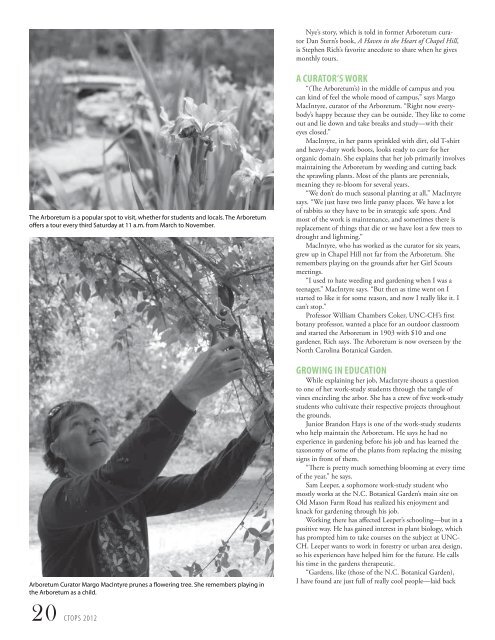See PDF version here. - Blue & White Online
See PDF version here. - Blue & White Online
See PDF version here. - Blue & White Online
You also want an ePaper? Increase the reach of your titles
YUMPU automatically turns print PDFs into web optimized ePapers that Google loves.
The Arboretum is a popular spot to visit, whether for students and locals. The Arboretum<br />
offers a tour every third Saturday at 11 a.m. from March to November.<br />
Arboretum Curator Margo MacIntyre prunes a flowering tree. She remembers playing in<br />
the Arboretum as a child.<br />
Nye’s story, which is told in former Arboretum curator<br />
Dan Stern’s book, A Haven in the Heart of Chapel Hill,<br />
is Stephen Rich’s favorite anecdote to share when he gives<br />
monthly tours.<br />
A cURATOR’S wORk<br />
“(The Arboretum’s) in the middle of campus and you<br />
can kind of feel the whole mood of campus,” says Margo<br />
MacIntyre, curator of the Arboretum. “Right now everybody’s<br />
happy because they can be outside. They like to come<br />
out and lie down and take breaks and study—with their<br />
eyes closed.”<br />
MacIntyre, in her pants sprinkled with dirt, old T-shirt<br />
and heavy-duty work boots, looks ready to care for her<br />
organic domain. She explains that her job primarily involves<br />
maintaining the Arboretum by weeding and cutting back<br />
the sprawling plants. Most of the plants are perennials,<br />
meaning they re-bloom for several years.<br />
“We don’t do much seasonal planting at all,” MacIntyre<br />
says. “We just have two little pansy places. We have a lot<br />
of rabbits so they have to be in strategic safe spots. And<br />
most of the work is maintenance, and sometimes t<strong>here</strong> is<br />
replacement of things that die or we have lost a few trees to<br />
drought and lightning.”<br />
MacIntyre, who has worked as the curator for six years,<br />
grew up in Chapel Hill not far from the Arboretum. She<br />
remembers playing on the grounds after her Girl Scouts<br />
meetings.<br />
“I used to hate weeding and gardening when I was a<br />
teenager,” MacIntyre says. “But then as time went on I<br />
started to like it for some reason, and now I really like it. I<br />
can’t stop.”<br />
Professor William Chambers Coker, UNC-CH’s first<br />
botany professor, wanted a place for an outdoor classroom<br />
and started the Arboretum in 1903 with $10 and one<br />
gardener, Rich says. The Arboretum is now overseen by the<br />
North Carolina Botanical Garden.<br />
GROwING IN EDUcATION<br />
While explaining her job, MacIntyre shouts a question<br />
to one of her work-study students through the tangle of<br />
vines encircling the arbor. She has a crew of five work-study<br />
students who cultivate their respective projects throughout<br />
the grounds.<br />
Junior Brandon Hays is one of the work-study students<br />
who help maintain the Arboretum. He says he had no<br />
experience in gardening before his job and has learned the<br />
taxonomy of some of the plants from replacing the missing<br />
signs in front of them.<br />
“T<strong>here</strong> is pretty much something blooming at every time<br />
of the year,” he says.<br />
Sam Leeper, a sophomore work-study student who<br />
mostly works at the N.C. Botanical Garden’s main site on<br />
Old Mason Farm Road has realized his enjoyment and<br />
knack for gardening through his job.<br />
Working t<strong>here</strong> has affected Leeper’s schooling—but in a<br />
positive way. He has gained interest in plant biology, which<br />
has prompted him to take courses on the subject at UNC-<br />
CH. Leeper wants to work in forestry or urban area design,<br />
so his experiences have helped him for the future. He calls<br />
his time in the gardens therapeutic.<br />
“Gardens, like (those of the N.C. Botanical Garden),<br />
I have found are just full of really cool people—laid back<br />
Swink pulls weeds from among plants in the garden. Most of the plants in the Arboretum are perennials, which means they<br />
re-bloom year after year.<br />
and fun to talk to—like other work-study students as well as<br />
full-time workers,” Leeper says. “I have made a lot of good<br />
friends.”<br />
STROLLING THROUGH HISTORY<br />
With a Southern drawl and a wide smile Rich shares the<br />
stories of the Arboretum, which he became familiar with during<br />
his time as a student at UNC-CH.<br />
“Every day I would be going from Cobb dorm to the<br />
fraternity,” Rich says, “so of course I would be going right<br />
through (the Arboretum). This always felt like home to me.”<br />
Rich warns that he could ramble on and on about the<br />
Arboretum; t<strong>here</strong> are countless stories about every little plant<br />
and path. As Rich walks through the Arboretum, he carries<br />
around a slightly worn copy of Stern’s book. Periodically<br />
referencing it for particular facts and showing off the beautiful<br />
pictures of the Arboretum, Rich seems to value the book,<br />
as the pages are bookmarked and article clippings are stuffed<br />
in the pages.<br />
At one point, Rich stops to comment on something most<br />
people completely overlook: the gravel covering the paths. He<br />
explains that the gravel, affectionately called ‘Carolina grit,’<br />
used to be all over campus, but for safety reasons, the paths<br />
were later bricked.<br />
“The story about the grit is (that) once you get Chapel<br />
Hill grit in your shoes, you are destined to return <strong>here</strong> one<br />
day,” Rich says. “T<strong>here</strong> is a counter story to that too. When<br />
people from Chapel Hill would go to Durham, the Durham<br />
people would go, ‘Oh those Chapel Hill people come<br />
with the dirtiest shoes,’ and the Chapel Hill people would<br />
retort by saying, ‘Well, we wouldn’t wear our good shoes to<br />
Durham.’”<br />
Rich also shares the story of a large stone area called the<br />
stone gathering circle. Located near the front of the Arboretum,<br />
it was donated by the class of 1997 in the memory of<br />
five students who died in the 1996 fire at the Phi Gamma<br />
Delta fraternity house. This beautiful area is a great place to<br />
sit and has a decoration of a poplar flower in the middle of<br />
the stone floor. Legend says that the center of the plant lines<br />
up with the Davie Poplar tree on the upper Quad.<br />
Rich, who is on the board of the N.C. Botanical Garden,<br />
is also part of a group that volunteers at the Arboretum.<br />
“We work every Tuesday—a group of older citizens,” Rich<br />
says. “We do whatever Margo wants us to do.”<br />
MEANT TO INSPIRE<br />
The early warm weather has brought even more students<br />
to this campus oasis. Petals float down lazily from the overhanging<br />
trees onto a student sprawled out on a bench. Several<br />
people have strung up hammocks. Sitting in a secluded spot,<br />
sophomore Adrienne Franz says she comes to the Arboretum<br />
several times a week.<br />
“It’s pretty this time of year,” Franz says. “It’s somew<strong>here</strong><br />
to be outside with nice benches.”<br />
The blooming flowers add their vibrant colors and sweet<br />
fragrances to the tall trees and the bright green of the abundant<br />
grass. A small stream flows over carefully positioned<br />
rocks.<br />
MacIntyre especially agrees with the part of the Arboretum’s<br />
mission that wishes to inspire visitors with the wonders<br />
of the grounds.<br />
“Everybody should visit the Arboretum,” MacIntyre says.<br />
“It’s always sad when people graduate and they have never<br />
come <strong>here</strong>.”<br />
&<br />
20 CTOPS 2012 www.blueandwhitemag.com 21



